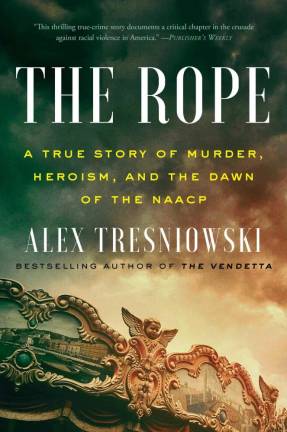A Book About Murder, Mystery and So Much More
Alex Tresniowski’s “The Rope” moves between the horrific murder of a ten-year old girl and the story of muckraking journalist and activist Ida B. Wells

Magazine writer and author Alex Tresniowski remembered hearing a story about a young girl named Marie Smith, who had been murdered in Asbury Park (yes, Springsteen’s town) in 1910. What did he do first? He visited the Holy Cross Cemetery in Brooklyn, where she had supposedly been buried. It took awhile, but he finally found a tiny unmarked grave. That clinched it.
No one had dug deep into the mystery, but Tresniowski moved forward and now has given readers a complex page-turner. The story turned out to include a man of color, (dubbed “Black Diamond”) unfairly imprisoned for the crime, an ingenious detective employing new psychological tactics, a trailblazing woman whose name is familiar in civil rights history, and, ultimately, the case that helped put the NAACP on the map.
“The Rope: A True Story of Murder, Heroism and the Dawn of the NAACP,” will be available February 5. Even though it takes place on the East Coast — and not the South—Jim Crow is the invisible character. Most impressively, the book manages to move fluidly between the horrific murder of a ten-year old girl, and the story of muckraking journalist and activist Ida B. Wells. The reader wonders how or when they are going to converge, but indeed they do.
“I wasn’t sure I could pull off the parallel stories,” admits Tresniowski, who lives in New York. “But I finally convinced myself there was a social context.” Much of his research came from periodicals like the Asbury Park Press (the murder had been a huge story at the time) and the pioneering detective — named Raymond C. Schindler — had been written about as well. The details here about his psychological mousetrap to get the killer to confess — which today might be considered entrapment — are right out of Sherlock Holmes.
“In fact, he was called a model for Holmes,” says the author. “Schindler never carried or pulled a gun, and his mother, who worked in a library inside a prison, convinced her son that we are all capable of bad things.” That impacted how Schindler nabbed the actual killer, previously thought to be a nice guy doing handiwork for locals. The title of the book refers both to the lynchings of the time — the expected ending for prisoner Thomas Williams — and the detective’s new methods of “roping” an unsuspecting suspect.
Although the book was completed before anyone was chanting the names of George Floyd and Breonna Taylor, its timing could hardly be better. “Absolutely,” says Tresniowski, “this is exactly what Ida Wells was fighting against. Even the mobs that attacked the Capitol this past week echoes. They were yelling ‘lynch Pence.’ History keeps repeating itself.” Pulitzer Prize winning journalist Nikole Hannah-Jones (“1619”) is one of the founders of the Ida B.Wells Society, which helps train journalists of color, and ensures that stories of social injustice are on every newsroom’s docket.
It will be surprising if “The Rope” is not turned into a movie or limited series, filled with at least four or five memorable characters. The books it most resembles are the bestsellers “Killing of the Flower Moon” and “Devil In The White City.” Leonardo DiCaprio is supposedly attached to both of those, so why not a third? No less a great writer than Walter Isaacson calls Tresniowski’s book “fascinating and important.” It’s hard to argue with that.